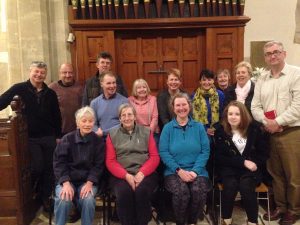We had a successful evening on Thursday 26 July with 8 potential recruits given an introduction to bellringing.
7 helpers came from Abingdon, Buckingham, and Maids Moreton to give support and encouragement with the addition of local ringers, Tower Captain Bob Hessian, Willie Haynes, Michael MacArthur, and Jeremy Adams.. The plan is that the new recruits will take part in a reasonably intensive (i.e. 10 hours) programme at W-o-t-G or possibly Bletchingdon, Kirtlington, Islip for instance as well. That’ll probably be an autumn project and we are extremely grateful to those who gave up their time (on one of the hottest evenings – so far!) to help.
Focussed practice 29th April 2018 at Bletchingdon
A really big thank you to all the helpers from four different branches who came to the focused practice at Bletchingdon this afternoon,organised and run by Alison Merryweather-Clarke.
This really benefitted six students, including Judith Vickars, Ellie Seddon, Sue Macready, Sue Carter, Immi (having just completed a Quarter Peal) and myself, who often wouldn’t get the chance to practice their favoured method with a such strong band.
The reward for the helpers was a selection of cakes, brownies and biscuits (baked by the students ) with cups of tea and coffee.
Sue C consolidated her ringing of Plain Hunt Doubles and tried different bells.
Sue M rang a few plain courses of Plain Bob Doubles, and then completed a couple of touches unaffected on 3.
Judith rang two unaffected touches of PBD on 3, then progressed to a 60 blow touch. Well done!
Immi rang some touches affected of Plain bob Doubles, trebled to Bob Minor then inside to a touch of bob Minor.
Ellie rang a number of different touches of Bob Minor.
Also a big thank you to Jane from Iffley, who stood with several students and gave very helpful guidance during the touches.
Several helpers and students commented afterwards on how valuable this session was.

ART Module 2C Teaching Course 10th February 2018
I arrived at St Peter’s Kineton, Warwickshire on a cold and wet Saturday morning. Kineton is an ART (Association of Ringing Teachers) teaching centre; in fact, it is the home tower of Graham Nabb, the Chair of ART itself.
Seven delegates attended this event, coming from as far afield as Essex and Wiltshire, several having many years’ ringing experience.
The aims of the course are to cover the teaching of key skills from Rounds through Plain Hunt (Foundation) to learning doubles and minor methods (Change Ringer).
The course, led by Graham, comprised a number of slides covering topics including:
- Challenges facing ringers and towers today
- How people learn
- The importance of combining theory, handling with practicing methods and having fun.
- Building an effective ringing team, including the importance of identifying and reviewing achievable objectives
- Placing the team for practice and service ringing.
- Duties of a tower captain and the importance of delegating key roles
- Health and Safety and Safeguarding
The theory sessions were interleaved with very useful and fun practical sessions. These included:
- Practicing rounds and leading using hand bells. Practicing whole pull and stand, then moving to next bell.
- Foundation skills, including standing the bell at hand and back stroke (Twinkle Twinkle little star, whole pull and stand, ring for n blows and stand, ring alternate hand and back stroke), turning while at back stroke, handing over rope to neighbour at hand stroke, switching hands on sally and tail end.
- Kaleidoscope ringing, Mexican Wave, call changes by places, dodge and change at each call
- Plain hunt on 3 – 6 bells, starting on back as well as hand stroke
- Techniques for those standing behind learners to encourage timely and correct striking, as well as the need to understand place and providing timely, specific and positive feedback.
- Mini-methods such as Cloister Doubles, Bastow Little bob and Churchyard bob to develop Plain Hunt skills
- Mini-touches of Plain Bob Doubles and Plain Bob Minor to encourage learners to treble and ring inside without the need to dodge
- Original Minor, developing the Band’s awareness of place and reaction to bobs and singles called.
- Touch of Grandsire Doubles with four consecutive singles, aka Reverse St Bartholemews Doubles.
All in all, this is an excellent course, which has given me many ideas to put into practice at my next ringing practices. I would thoroughly recommend the ART ringing scheme to any ringing learner or teacher as a structured, graded programme that breaks down handling and ringing techniques into smaller elements, enabling the student to progress. Learners and teachers are well supported through a comprehensive set of learning and teaching resources.
The ART teaching modules comprise Module 1 (handling), Module 2F (Foundation – Rounds to Plain Hunt) and Module 2C (Methods).
For further details, speak to me or visit the websites at: https://smartringer.org/ or http://ringingteachers.org/
Steve Vickars
Spliced anyone? 16 July 2016
On Saturday 16th July we held our annual branch training course. Following successive years of Ringing Up & Down this year we held a rope splicing course.
Stratton Audley hosted the course where 6 students came along to try both short and long splices. I demonstrated a short splice first of all and then (thanks to Steve for bringing some old ropes – unusable as bell ropes anymore due to their length/past breakages) we headed into the sunny churchyard to have a go. Results were mixed – some having difficulties and others finding it easier (and the resulting “fixed” ropes resulted in the odd tug of war to test their strength).
After a couple of hours trying we moved on to long splices (Jeremy had got ahead of us following the instructions printed off the website).. I demonstrated how to do a long splice and then the students had a go, again with mixed results.
It was the first time I had taught splicing so that was interesting and I have picked up some traps to watch out for another time, and the students seemed to enjoy the practice too.
Anthony Cole
Apply now for Radley 2016 ringing course
Message from the Guild Representative.
One of the things that the Guild provides for all members, is to run courses.
The next course to be run is at Radley (near Abingdon) on Saturday 9th April 2016 and applications need to be in by 31st January.
See http://odg.org.uk/pdf/Radley2016.pdf poster for how to apply, or use Guild Website link below.
These courses provide an excellent opportunity for anyone needing help in learning methods. The Radley course covers basic methods such as Plain Bob Doubles and Grandsire doubles, and is for all members meeting the criteria outlined below.
(The Guild also runs courses for more advanced methods at other times in the year, see the guild website for details, Education tab).
Oxford Diocesan Guild of Church Bell Ringers
Education Committee
Ringing Criteria for the Radley Course
To ensure the safety of the students, helpers and tutors on this course a standard of ringing competence and understanding is required.
While we try to make sure that all of the bells we use are suitable for teaching, they may be much lighter or heavier than the bells in your home tower, there may be steps or ladders to access the ringing room, the length of the draught may be much longer or shorter than you are used to, and there may be any number of other peculiarities to deal with. For this reason, we ask that you are able to ring a bell competently and confidently on your own, and you should ideally have experience of ringing a range of different bells, including bells in other towers, so that you are not impeded in your progress and can take full advantage of the tuition provided on the course.
All students must be members of the Oxford Diocesan Guild, and therefore regular Sunday service ringers.
The tower Captain or Tower ringing Tutor should fill in the ringing ability section on the application form giving their name to this.
If the student is under 18 a permission to ring form needs to be filled in and this will be forwarded on receipt of the application. A parent or an appointed responsible adult needs to be present on the course. This could be a helper.
This criteria will also help the tutor to plan the course as they will be aware that the student understands these requirements.
From the point of view of the student, the day goes like this:
Meet at the hall approx 9 am
Tea and coffee available. Bookstall also available.
Meet the other students in your group, and your tutor.
Students are put into groups of 5 people, according to the method they requested.
Theory for about 1 hour, then travel to your first tower. Cars are shared, so that less parking space is needed.
At the first tower, you will meet the helpers. In my experience, the helpers always ring up and down at the first tower (volunteers at later sessions). Early on, you will need to select your meal for the pub lunch (or you can take your own packed lunch).
The tutor then needs to find out what each student can do, so each student in turn has a go (together with 5 helpers).
Each tower session is 1½ hours, so at the first tower, each student will probably get 2 goes.
Pub Lunch
In the afternoon, there will be 2 more tower sessions, and they will develop according to everyone’s ability. The tutor may keep to only one student at a time, or he/she may include two or more students at a time.
The great advantage of these courses is that, as a learner, you are surrounded by helpers who know the method well, as well as a tutor standing by to help you. This is a brilliant way to get to know a method, and I would thoroughly recommend these courses.
After the 3rd tower session, everyone returns to the hall, where a meal is provided (cooked by volunteers, and is always excellent). The tutors give a short summary of their class, and certificates are provided. The day finishes at around 8pm.
For the last couple of years, applications for the basic methods courses were very low, but are now rising again. I would encourage anyone who needs some help with a method to go on one of these courses. (They are not just for some mysterious elite ringers. All who meet the criteria above may apply). The day is long, but very satisfying and beneficial.
I have attended a few of these courses myself. If anyone has any questions, or needs a bit more encouragement to go, please feel free to email me.
Anne Martin
Steeple Aston course October 2015
On Sat 24th Oct students and helpers from across the Guild headed for Steeple Aston and ringing or teaching one of 5 methods.
The students were given a briefing before heading out to towers. I was there as a helper on the Grandsire Triples course so I headed for Steeple Aston Church. After sorting out lunch menu choices we rang a variation on plain hunt on 7 (Grandsire start though) and then progressed to plain courses of Grandsire Triples.
Lunch was at the Red Lion in Steeple Aston and was a chance for learners to get to know their helpers and vice versa.
Next we headed for Islip where Teresa was cajoled into ringing with us as an extra helper. We mainly rang plain courses but a few bobs and singles were introduced to some of the learners. We also had some dodging practice to help get the Grandsire dodges right.
Finally we headed for Kirtlington which were heavier and which posed a bit of a problem for one learner but they do sound lovely. More plain courses and then all students got to try out bobs and singles – an introduction for three and perfecting for two.
From my perspective as a helper I found it was a good day with progress made by our students which is always good to see. I also got to ring touches of Grandsire Triples which I’m sad to say is all too rare in the Bicester branch but a good refresher for me.
One branch member was on the Grandsire Doubles course so hoping to hear of lots of progress made and a step forward for future branch practices.
Anthony Cole

